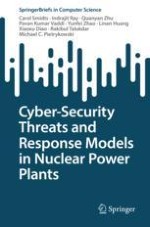This SpringerBrief presents a brief introduction to probabilistic risk assessment (PRA), followed by a discussion of abnormal event detection techniques in industrial control systems (ICS). It also provides an introduction to the use of game theory for the development of cyber-attack response models and a discussion on the experimental testbeds used for ICS cyber security research. The probabilistic risk assessment framework used by the nuclear industry provides a valid framework to understand the impacts of cyber-attacks in the physical world. An introduction to the PRA techniques such as fault trees, and event trees is provided along with a discussion on different levels of PRA and the application of PRA techniques in the context of cybersecurity. A discussion on machine learning based fault detection and diagnosis (FDD) methods and cyber-attack detection methods for industrial control systems are introduced in this book as well.
A dynamic Bayesian networks based method that can be used to detect an abnormal event and classify it as either a component fault induced safety event or a cyber-attack is discussed. An introduction to the stochastic game formulation of the attacker-defender interaction in the context of cyber-attacks on industrial control systems to compute optimal response strategies is presented. Besides supporting cyber-attack response, the analysis based on the game model also supports the behavioral study of the defender and the attacker during a cyber-attack, and the results can then be used to analyze the risk to the system caused by a cyber-attack. A brief review of the current state of experimental testbeds used in ICS cybersecurity research and a comparison of the structures of various testbeds and the attack scenarios supported by those testbeds is included. A description of a testbed for nuclear power applications, followed by a discussion on the design of experiments that can be carried out on the testbed and the associated results is covered as well.
This SpringerBrief is a useful resource tool for researchers working in the areas of cyber security for industrial control systems, energy systems and cyber physical systems. Advanced-level students that study these topics will also find this SpringerBrief useful as a study guide.
